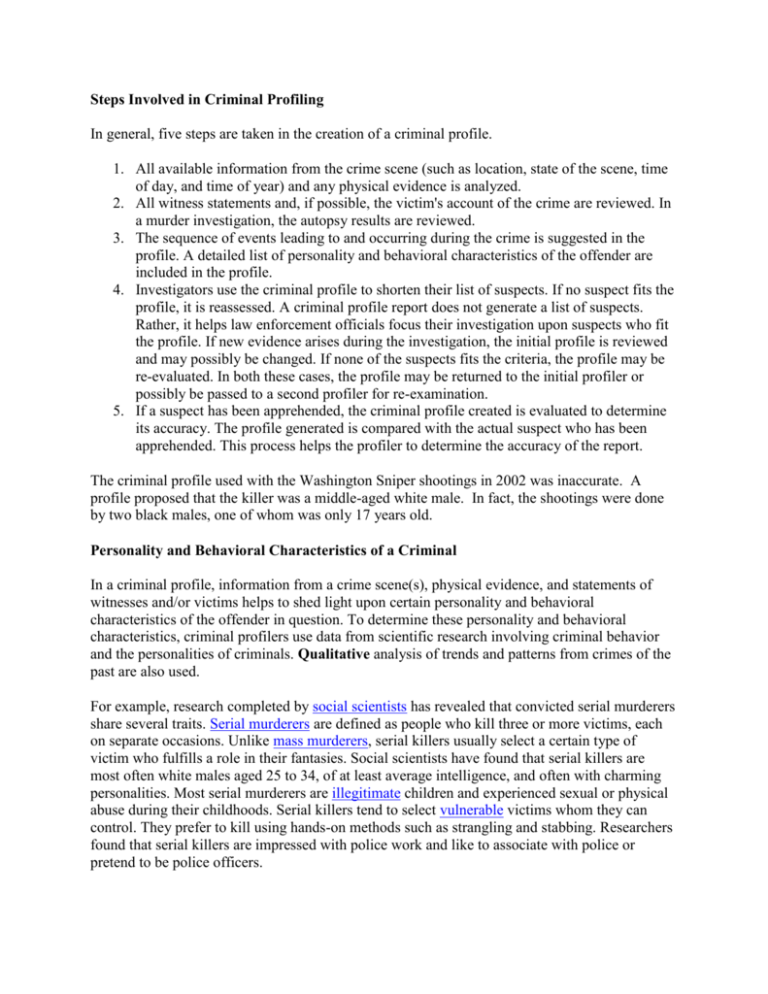Steps Involved in Criminal Profiling In general, five steps are taken
advertisement

Steps Involved in Criminal Profiling In general, five steps are taken in the creation of a criminal profile. 1. All available information from the crime scene (such as location, state of the scene, time of day, and time of year) and any physical evidence is analyzed. 2. All witness statements and, if possible, the victim's account of the crime are reviewed. In a murder investigation, the autopsy results are reviewed. 3. The sequence of events leading to and occurring during the crime is suggested in the profile. A detailed list of personality and behavioral characteristics of the offender are included in the profile. 4. Investigators use the criminal profile to shorten their list of suspects. If no suspect fits the profile, it is reassessed. A criminal profile report does not generate a list of suspects. Rather, it helps law enforcement officials focus their investigation upon suspects who fit the profile. If new evidence arises during the investigation, the initial profile is reviewed and may possibly be changed. If none of the suspects fits the criteria, the profile may be re-evaluated. In both these cases, the profile may be returned to the initial profiler or possibly be passed to a second profiler for re-examination. 5. If a suspect has been apprehended, the criminal profile created is evaluated to determine its accuracy. The profile generated is compared with the actual suspect who has been apprehended. This process helps the profiler to determine the accuracy of the report. The criminal profile used with the Washington Sniper shootings in 2002 was inaccurate. A profile proposed that the killer was a middle-aged white male. In fact, the shootings were done by two black males, one of whom was only 17 years old. Personality and Behavioral Characteristics of a Criminal In a criminal profile, information from a crime scene(s), physical evidence, and statements of witnesses and/or victims helps to shed light upon certain personality and behavioral characteristics of the offender in question. To determine these personality and behavioral characteristics, criminal profilers use data from scientific research involving criminal behavior and the personalities of criminals. Qualitative analysis of trends and patterns from crimes of the past are also used. For example, research completed by social scientists has revealed that convicted serial murderers share several traits. Serial murderers are defined as people who kill three or more victims, each on separate occasions. Unlike mass murderers, serial killers usually select a certain type of victim who fulfills a role in their fantasies. Social scientists have found that serial killers are most often white males aged 25 to 34, of at least average intelligence, and often with charming personalities. Most serial murderers are illegitimate children and experienced sexual or physical abuse during their childhoods. Serial killers tend to select vulnerable victims whom they can control. They prefer to kill using hands-on methods such as strangling and stabbing. Researchers found that serial killers are impressed with police work and like to associate with police or pretend to be police officers. Criminal profilers will state only the behavioral and personality characteristics that can be justified from the information they have gathered from the case in question. In other words, criminal profilers outline only the behavioral and personality characteristics they can explain using research data and valid trends and patterns about convicted criminals. Serial murderers are difficult to apprehend because they plan their murders, often travel long distances between their crimes, and frequently wait months between killings. Some of the behavioral and personality characteristics often found in a criminal profile include the following: Age: usually given as a range of possible ages for the suspect (For example, most serial killers are between the ages of 20 and 35 years while 75% of all sexual assaults are committed by culprits that are less than 25 year.) Gender: often determined by the gender of the victims and the nature of the crime scene (For example, 75% of all sex assaults are committed by white males.) Ancestry: usually the same as the first victim Residency: determined by using geographical profiling Intelligence Level: higher level of intelligence, especially in carefully planned crimes Occupation: consistently employed in certain types of positions or recently employed (For example, most serial arsonists are employed in subservient positions, and many mass murderers have experienced recent job loss.) Marital Status: varies among single, married, separated, divorced, or widowed (For example, most sex offenders and pedophiles are single.) Motivating Factors: whether the crime was random or planned in detail (For example, little physical evidence at a crime scene that appears unaltered often indicates the crime was premeditated. The nature of a victim's injuries may indicate whether the suspect had personal anger towards the victim.) Arrest Record: often committed by a suspect with an arrest record or by someone who has committed crimes but has not been caught Provocation Factors: ways to cause perpetrators to come forward (For example, criminal profilers often suggest methods to draw out the suspect.)











